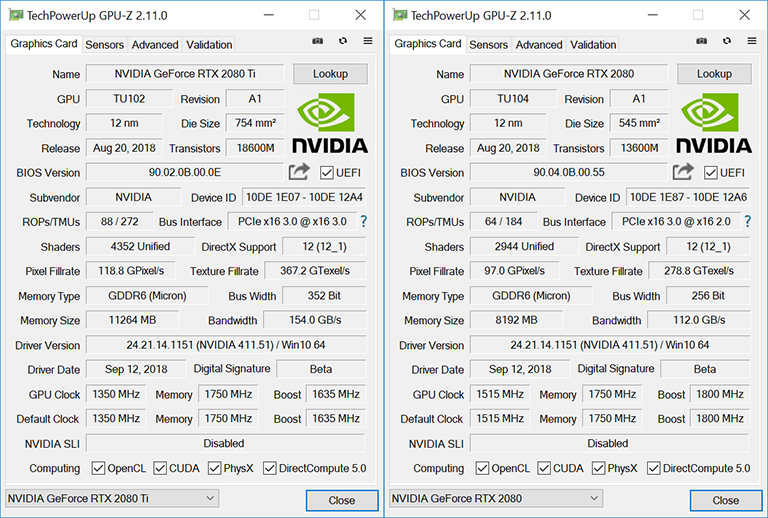Test Methodology
Nvidia GeForce RTX 2080 Ti and RTX 2080 Specifications |
|---|
 |
GPU Comparisons |
||||||||||
|---|---|---|---|---|---|---|---|---|---|---|
GPU |
Memory |
Miscellaneous |
||||||||
Cores |
Base (MHz) |
Boost (MHz) |
Type |
Size (MB) |
Clock (MHz) |
Bus (bits) |
Power Config |
Driver |
||
| Nvidia GeForce RTX 2080 Ti FE | 4,352 |
1,350 |
1635 |
GDDR6 |
11,264 |
14,000 |
352 |
8+8 |
411.51 |
|
| Nvidia GeForce RTX 2080 FE | 2,944 |
1,515 |
1,800 |
GDDR6 |
8,192 |
14,000 |
256 |
6+8 |
411.51 |
|
| Nvidia GeForce GTX 1080 Ti FE | 3,584 |
1,481 |
1,582 |
GDDR5X |
11,264 |
11,000 |
352 |
6+8 |
399.27 |
|
| Nvidia GeForce GTX 1080 FE | 2,560 |
1,607 |
1,734 |
GDDR5 |
8,192 |
10,010 |
256 |
8 |
399.27 |
|
| Nvidia GeForce GTX 1060 FE | 1,280 |
1,506 |
1,683 |
GDDR5 |
6,144 |
8,008 |
192 |
6 |
399.27 |
|
| AMD Radeon RX Vega 64 | 4,096 |
1,247 |
1,546 |
HBM2 |
8,192 |
945 |
2,048 |
8+8 |
18.8.2 |
|
| AMD Radeon RX Vega 56 | 3,584 |
1,156 |
1,471 |
HBM2 |
8,192 |
800 |
2,048 |
8+8 |
18.8.2 |
|
| AMD Radeon RX 580 | 2,304 |
- |
1,450 |
GDDR5 |
8,192 |
8,000 |
256 |
6+8 |
18.8.2 |
|
HEXUS GPU Test Bench |
||
|---|---|---|
| Hardware Components | Product Page | |
| Processor | Intel Core i7-8700K (overclocked to all-core 4.8GHz) | intel.com |
| Motherboard | Asus ROG Maximus X Hero | asus.com |
| Memory | G.Skill Trident Z 32GB (2x16GB) DDR4-3200 | gskill.com |
| Power Supply | be quiet! Dark Power Pro 11 1,000W | bequiet.com |
| Primary Storage | 256GB WD Black PCIe SSD | wdc.com |
| Secondary Storage | 1TB Crucial MX300 SATA SSD | crucial.com |
| Chassis | be quiet! Dark Base 700 | bequiet.com |
| Monitor | iiyama ProLite X4071UHSU-B1 | iiyama.com |
| Operating system | Windows 10 Pro | microsoft.com |
Benchmark Suite |
||
|---|---|---|
| Synthetic Benchmarks | ||
| 3DMark | Time Spy and Time Spy Stress Test | |
| Gaming Benchmarks and Settings | ||
| Civilization VI | DX11, MSAA, Ultra Quality | |
| Far Cry 5 | DX11, TAA, Ultra Quality | |
| Forza Motorsport 7 | DX11, TAA, Ultra Quality | |
| Gears of War 4 | DX11, TAA, Ultra Quality | |
| Middle-earth: Shadow of War | DX11, TAA, Ultra Quality | |
| Total War: Warhammer II | DX12, FXAA, Ultra Quality | |
| World of Tanks PT | DX11, TSSAA, Ultra Quality | |
| General Benchmarks | ||
| Power Consumption | To emulate real-world usage scenarios, we record system-wide mains power draw both when idle and while playing Far Cry 5 | |
| Temperature | To emulate real-world usage scenarios, we record GPU core temperature both when idle and while playing Far Cry 5 | |
| Noise | A PCE-318 meter is used to record noise levels when idle and while playing Far Cry 5 | |
| Overclocking | Maintaining out-the-box voltage, we increase the card's power target and aim for an optimal balance of core and memory overclock. | |
Notes
We have tested seven cards from the ground up for this performance evaluation, all benchmarked on the latest drivers at the time of writing. A lot of the suspects are obvious. The GeForce GTX 1060 6GB's inclusion is interesting insofar as it is, by some distance, the most popular GPU on Steam's Hardware Survey. It's also useful because, going by previous results, the card's performance is just above the GeForce GTX 970 and just below the GTX 980, providing you with further insight if your card is from that generation.
Aside from the new cards, this is the first review with our Core i7-8700K platform overclocked to an all-core 4.8GHz. Expect a little more oomph than the now-retired Core i7-6700K used for the vast bulk of previous GPU testing.
Last but not least, we have chosen a number of eclectic benchmarks that test the full gamut of a card's capabilities. Some games are old(er), some are wildly popular, while some make even the GeForce RTX 2080 Ti squeal a little at 4K. All games are set to their maximum quality level.









